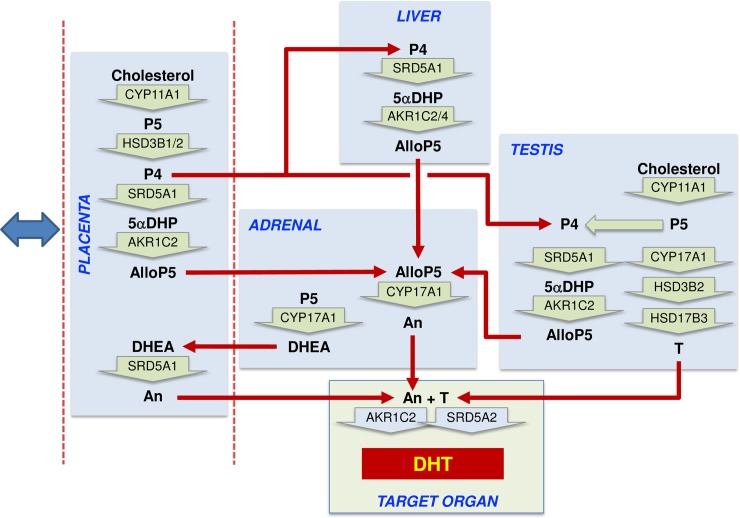File:Model male androsterone synthesis.jpg
Model_male_androsterone_synthesis.jpg (740 × 518 pixels, file size: 92 KB, MIME type: image/jpeg)
Proposed steroidogenic pathways in the second trimester human male fetus
See also Alternate androgen synthesis pathway
Proposed steroidogenic pathways leading to androsterone synthesis and masculinization in the second trimester human male fetus.
Steroid hormone conversion is shown by wide green arrows, with the converting enzymes written within the arrow. Red arrows show potential transport between organs in the fetal circulation. The blue double-headed arrow indicates that exchange is also taking place between the placenta and the maternal circulation. Most circulating progesterone in the fetal circulation is likely to come from the placenta, and this will be reduced to 5αDHP by SRD5A1 in the placenta, fetal liver, and fetal testis, with the fetal liver likely to be the major site. Allopregnanolone (AlloP5) production by AKR1C2 is also most likely to occur in the placenta and fetal liver because the substrate is present in those tissues, and they express the highest total levels of enzyme transcript. Some conversion may also occur in the testis. Significant levels of androsterone are only detectable in the placenta and adrenal, and thus they are a likely source of the circulating steroid, although, given sex differences, other tissues are probably involved. The adrenal lacks other intermediates in the backdoor pathway, and thus AlloP5 must come from other tissues. The placenta lacks CYP17A1, so androsterone production is likely to depend on adrenal DHEA as substrate. Testosterone from the fetal testes also acts as an essential substrate for DHT synthesis at the external genitalia.
AlloP5, allopregnanolone; An, androsterone; DHEA, dehydroepiandrosterone; DHT, 5α-dihydrotestosterone; P4, progesterone; P5, pregnenolone; T, testosterone; 5αDHP, 5α-dihydroprogesterone; CYP17A1, Cytochrome P450 Family 17 Subfamily A Member 1
Reference
O'Shaughnessy PJ, Antignac JP, Le Bizec B, Morvan ML, Svechnikov K, Söder O, Savchuk I, Monteiro A, Soffientini U, Johnston ZC, Bellingham M, Hough D, Walker N, Filis P & Fowler PA. (2019). Alternative (backdoor) androgen production and masculinization in the human fetus. PLoS Biol. , 17, e3000002. PMID: 30763313 DOI.
Copyright
© 2019 O’Shaughnessy et al. This is an open access article distributed under the terms of the Creative Commons Attribution License, which permits unrestricted use, distribution, and reproduction in any medium, provided the original author and source are credited.
Pbio.3000002.g006.jpg
Cite this page: Hill, M.A. (2024, April 26) Embryology Model male androsterone synthesis.jpg. Retrieved from https://embryology.med.unsw.edu.au/embryology/index.php/File:Model_male_androsterone_synthesis.jpg
- © Dr Mark Hill 2024, UNSW Embryology ISBN: 978 0 7334 2609 4 - UNSW CRICOS Provider Code No. 00098G
File history
Click on a date/time to view the file as it appeared at that time.
| Date/Time | Thumbnail | Dimensions | User | Comment | |
|---|---|---|---|---|---|
| current | 12:22, 5 March 2019 |  | 740 × 518 (92 KB) | Z8600021 (talk | contribs) | ==Proposed steroidogenic pathways in the second trimester human male fetus== Proposed steroidogenic pathways leading to androsterone synthesis and masculinization in the second trimester human male fetus. Steroid hormone conversion is shown by wide g... |
You cannot overwrite this file.
File usage
The following 6 pages use this file:
